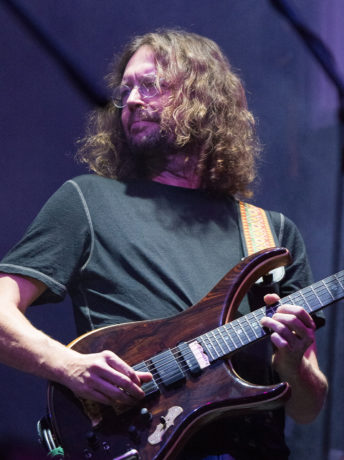While American folk band the Grateful Dead officially disbanded shortly after the death of frontman Jerry Garcia in 1995, the Dead has lived on in numerous “post-Jerry” incarnations. Few people have been as close to the post-Jerry Dead scene as guitarist and musician John Kadlecik.
Kadlecik’s music career is long and varied, but to my mind, the most crucial fact to an understanding of his music is this: He started a Dead cover band (Dark Star Orchestra) in 1997 and was so good at replicating Jerry Garcia’s sound on guitar and vocals that in 2009, the surviving members of the Grateful Dead invited him to play lead guitar and vocals (ie. “the Jerry parts”) in their newly formed band Furthur.

As a founding member of Furthur, Kadlecik played with original Dead members Bob Weir (rhythm guitar), and Phil Lesh (bass) from 2009-2014. He continues to collaborate regularly with Weir and Lesh and other notable musicians in the Dead music scene: Oteil Burbridge (current Dead & Co. bass player), Jeff Chimenti (current Dead & Co. keyboard player), and Melvin Seals (longtime member of the Jerry Garcia Band).
Unabashed Deadhead that I am, when I heard Kadlecik was playing at The Hamilton in DC this week with The Golden Gate Wingmen (one of the four bands he currently heads), I reached out to ask him some questions about his career. Here’s what I learned.
Though Kadlecik is associated with the Dead, his own music training goes far beyond Dead songs. He started playing violin as a child and received classical training throughout middle school and into high school until a family move from Iowa to suburban Chicago took him to “a very large school with a small and dismal music program.” This led him to switch from violin to guitar and from classical training to musical improvisation. “The first time I got together with a bass player and drummer we jammed on the 12-bar blues for like an hour,” he said. By the time high school ended he had extensive ear training and was skilled at reading sheet music and tablature. He could play violin, guitar, piano, drums, and mandolin. With little family support, he forged a music career “100% funded by crappy high school and post-high school jobs.”
Kadlecik explained to me that when he first encountered the Dead late in high school, he had already worked through the music catalogs of Led Zeppelin, Pink Floyd, and Rush and was analyzing “how electric guitarists get their tone by their touch.” I asked him to explain what he meant by that and he elaborated: “I didn’t have the money for expensive gear when I was young so I tuned in to how a guitarist played.” His conclusion: “A guitarist’s tone comes 90% from their heart and their fingers. No more than 10% comes from the equipment they use.”
Knowing I am a theater person, Kadlecik framed the idea in a helpful theater analogy for me: “To approximate a guitarist’s style is kind of like an actor learning an accent. It’s just a skill. It’s not some sort of magical wizardry thing. It’s just something guitarists do.”
Because he rose to prominence in the Dead community for replicating Dead shows and Jerry’s sound specifically, Kadlecik has faced criticism among some Deadheads for copying the sound rather than being stylistically innovative. With that in mind, I asked Kadlecik to describe the philosophy behind Dark Star Orchestra’s approach to recreating specific Grateful Dead performances.
“With the Dark Star Orchestra, there is the common misconception that we played things note for note but what we really did was analyze three to six versions of a song from a given year and try to dial in to how that song was evolving in that year. We tried to figure out what pieces were essential for the song to achieve that sound and what pieces could be twisted around [through improvisation] to suit the moment.
“It was more like growing a plant than doing a paint by number. You know, if you’re growing an oak tree, for example, it’s always going to have a certain kind of leaf and bark but the branching is going to be different, the height, the degree of shade, all these things are going to be different for every tree that grows. That’s how I think about what we were doing. We rendered from the DNA of the song and tried to evolve it to 1976 or whatever year we were aiming for.”

Our conversation then turned to the debate among Deadheads over who “plays Jerry” best. Some people dismiss all post-Jerry incarnations of Dead bands while other fans tend to have a favorite post-Jerry guitarist. Opinions get heated. I asked Kadlecik how he reacts when hearing this talk of preferring one guitarist over another.
“I don’t know,” he laughs, “I just do what I do. You know the thing is, the Dead scene’s been like that for a long time. You can go back to The Grateful Dead Movie (1977) which Jerry directed. They included a disgruntled audience member saying ‘this is the biggest bunch of crap the Grateful Dead has ever done.’
“Deadheads haven’t agreed on much from day one except that they like Grateful Dead music.”
The “Fare Thee Well” tour in 2015 brought a revitalized national interest to the Dead, putting the surviving members of the band back into large concert venues (Trey Anastasio of Phish played lead guitar on that tour). This Dead resurgence continues now with Dead & Co., which sees original Grateful Dead members Bob Weir, Mickey Hart, and Bill Kreutzmann playing huge stadiums with Jeff Chimenti on keys, Oteil Burbridge on bass and, love him or hate him (and boy do opinions among Deadheads vary!), John Mayer on guitar.
Kadlecik declined to join the fray when I asked his opinion on John Mayer, instead emphasizing his fondness for the members of the band he has worked with in the past:
“You know, I love Bobby and I love Jeff and Oteil, and I’m happy to see the drummers playing together and getting to do good gigs.
He did contrast the repertoire of Dead & Co., whose setlists have so far been a confined number of Dead songs, to that of Furthur. “One of the things I’m most proud of with Furthur is that we were focused from the first day of rehearsal on new original songs. Over the course of four years of playing, we genuinely picked up where the Dead were leaving off in terms of the output of new original and unfamiliar cover material. Pick any four years of the Grateful Dead as far as how many new songs they were introducing into the live show, we were right there on pace with any of that.”
Kadlecik says his time with Furthur was like being a part of a family enterprise “in that there was nobody working further up the ladder than Bobby and Phil. It was like a really cool mom and pop – or pop and pop – business.”
These days, Kadlecik is focused on playing live as much as possible. He leads four bands, including the Golden Gate Wingman and his own John Kadlecik Band, and he sits in regularly with other musicians.

Throughout our conversation, it was clear that Kadlecik places great emphasis on the power and beauty of improvisation so I asked him what he thinks the secret is to great musical collaboration. What makes one group work great and another fizzle?
He described it as “a minor miracle” when a group of musicians finishes even one song. “Bands are actually a very complex social experiment. Most art is not made collaboratively. The bulk of art is usually made by a solitary individual.” But bands, and especially bands that incorporate a great deal of improvisation into their performance, must work off of each other.
Applying this philosophy to the Golden Gate Wingmen, comprised of Jeff Chimenti on keyboards, Jay Lane on drums, (both formerly of Furthur) and Reed Mathis on bass, Kadlecik says “we had a lot of back chemistry. Our backgrounds all overlap in interesting ways that feed us and give us a longer sense of the melodic underpinning of improvisation.”
With the Golden Gate Wingmen, Kadlecik feels lucky to be able to play with what he calls his “A-team” of friends and musicians. Players who have known each other awhile but also discovered that their attitude toward music meshed so well that they were able to skip right to the joy of improvising. “This showed up fully formed the first time we played together,” he said. “Which is also just luck.”
The Golden Gate Wingmen play on Wednesday, March 21, 2018, at The Hamilton – 600 14th Street, NW, in Washington, DC. For tickets, call (202) 769-0122 or go online.




